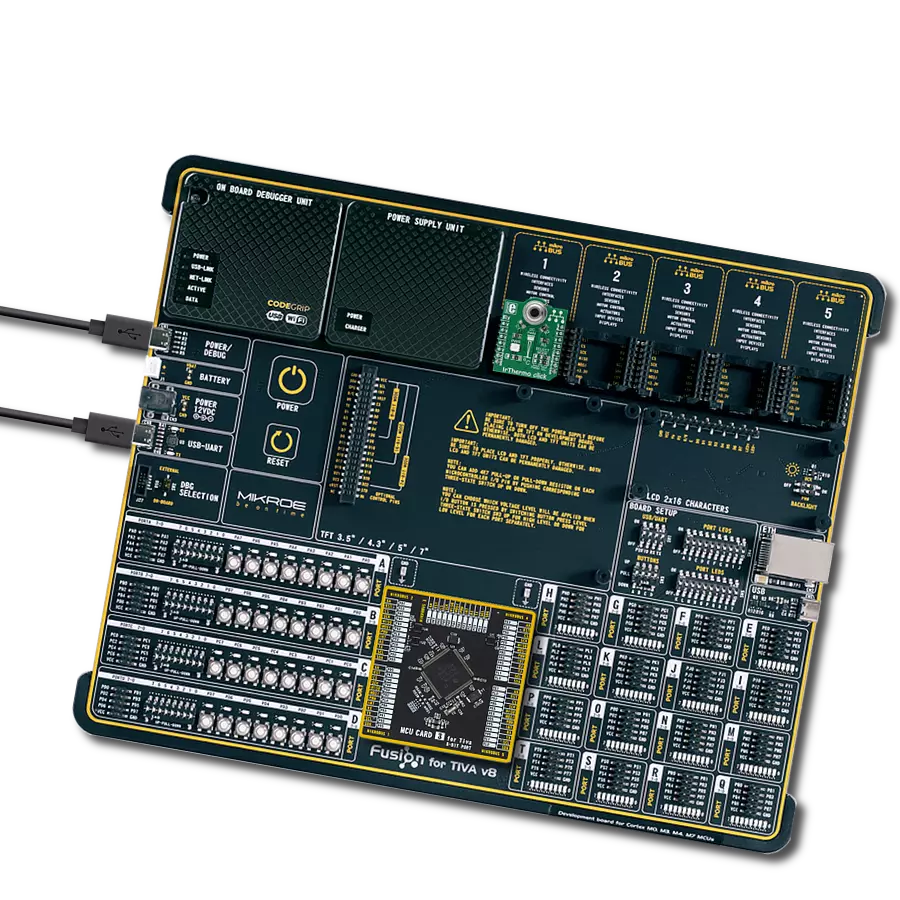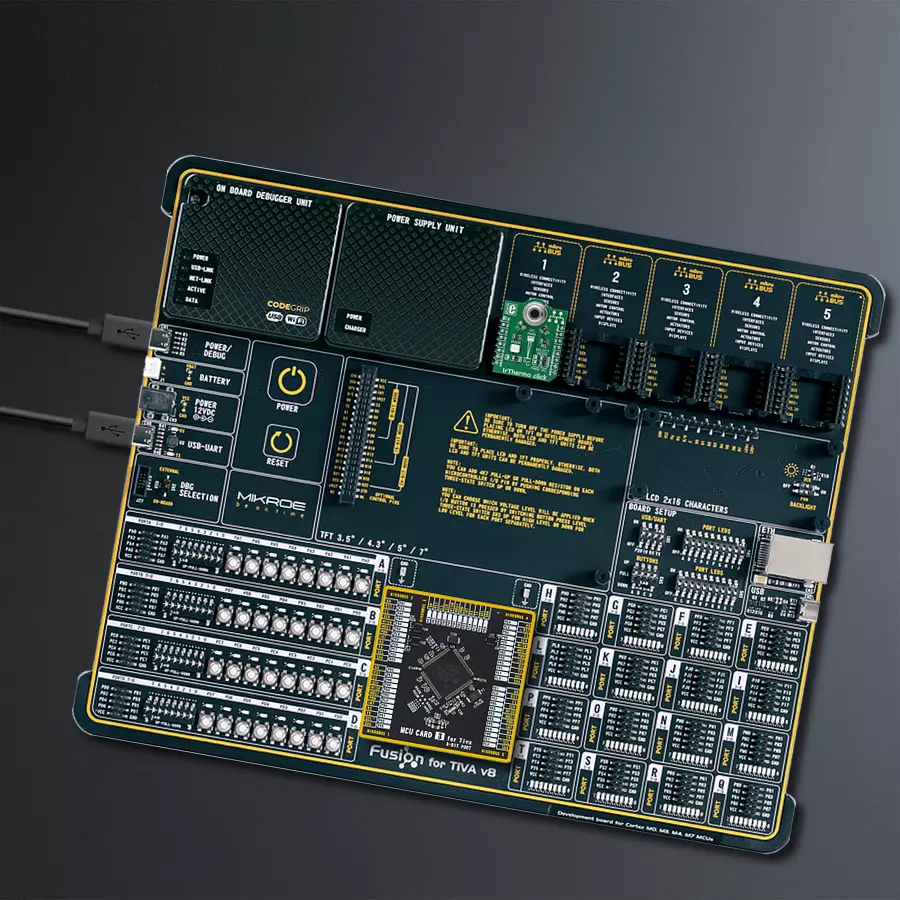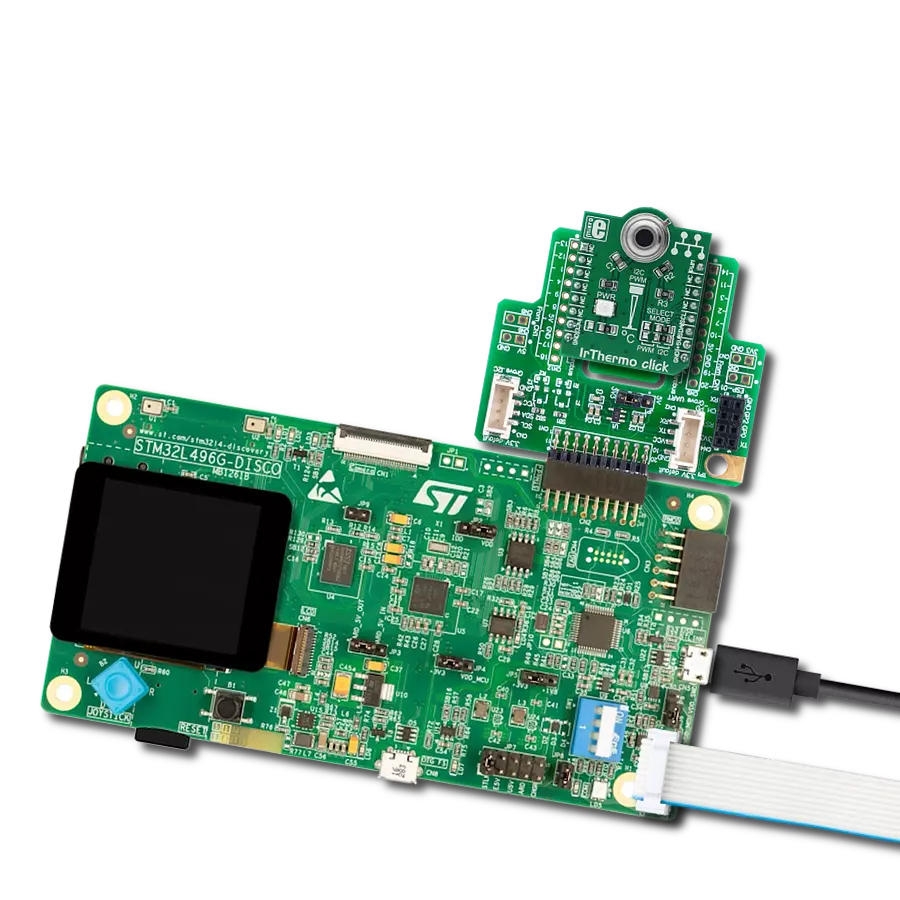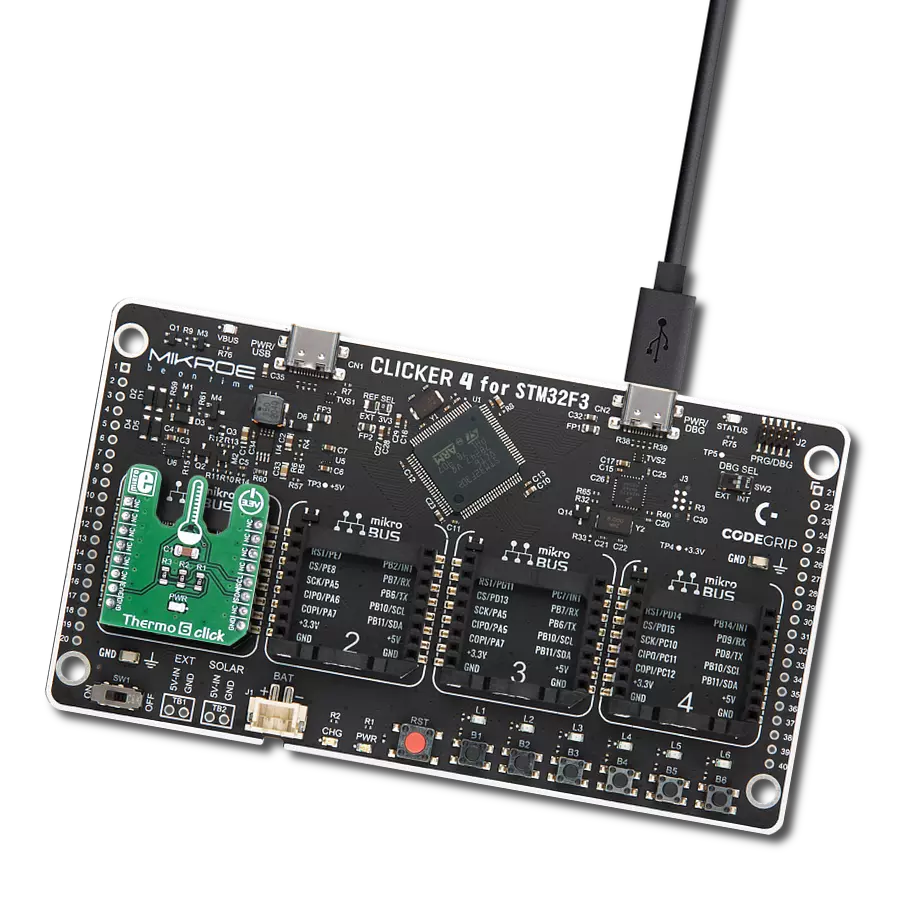Experience a secure temperature monitoring solution that keeps you cool and safe, eliminating the necessity for physical contact
A
A
Hardware Overview
How does it work?
IrThermo Click is based on the MLX90614, a single and dual-zone infrared thermometer from Melexis. This sensor is an IR sensor of a thermopile character. A thermopile sensor is a serially connected thermocouple array with hot junctions on the heat-absorbing membrane. The cold junctions are located on a cold base, providing the reference point for generating the voltage. Due to the low-temperature capacity of the membrane, it will react to the heat radiation, generating voltage via the thermoelectric effect. The ASSP circuitry of the MLX90614 sensor processes the voltage, allowing an accuracy of ±0.5˚C. The MLX90614 sensor is
factory calibrated in a wide temperature range: -40°C to 125°C for sensor temperature and -70°C to 380°C for object temperature. The ASSP circuitry also provides advanced interfacing options for the MCU, with the CRC error checking. The MLX90614 is equipped with a portion of EEPROM, which stores various config parameters, calibration data, and the chip ID address. Changing the values in the EEPROM will only take effect once the device is restarted. IrThermo Click 5V can use the SMBus to communicate with the host MCU using I2C lines of the mikroBUS™ socket. In addition, you can use the 10-bit PWM for data output to the host MCU.
The selection can be made over the SELECT MODE jumper, where the I2C is selected by default. For this Click board™ to work properly, both jumpers should be set to appropriate positions. This Click board™ can be operated only with a 5V logic voltage level. The board must perform appropriate logic voltage level conversion before using MCUs with different logic levels. Also, it comes equipped with a library containing functions and an example code that can be used as a reference for further development.
Features overview
Development board
Fusion for TIVA v8 is a development board specially designed for the needs of rapid development of embedded applications. It supports a wide range of microcontrollers, such as different 32-bit ARM® Cortex®-M based MCUs from Texas Instruments, regardless of their number of pins, and a broad set of unique functions, such as the first-ever embedded debugger/programmer over a WiFi network. The development board is well organized and designed so that the end-user has all the necessary elements, such as switches, buttons, indicators, connectors, and others, in one place. Thanks to innovative manufacturing technology, Fusion for TIVA v8 provides a fluid and immersive working experience, allowing access
anywhere and under any circumstances at any time. Each part of the Fusion for TIVA v8 development board contains the components necessary for the most efficient operation of the same board. An advanced integrated CODEGRIP programmer/debugger module offers many valuable programming/debugging options, including support for JTAG, SWD, and SWO Trace (Single Wire Output)), and seamless integration with the Mikroe software environment. Besides, it also includes a clean and regulated power supply module for the development board. It can use a wide range of external power sources, including a battery, an external 12V power supply, and a power source via the USB Type-C (USB-C) connector.
Communication options such as USB-UART, USB HOST/DEVICE, CAN (on the MCU card, if supported), and Ethernet is also included. In addition, it also has the well-established mikroBUS™ standard, a standardized socket for the MCU card (SiBRAIN standard), and two display options for the TFT board line of products and character-based LCD. Fusion for TIVA v8 is an integral part of the Mikroe ecosystem for rapid development. Natively supported by Mikroe software tools, it covers many aspects of prototyping and development thanks to a considerable number of different Click boards™ (over a thousand boards), the number of which is growing every day.
Microcontroller Overview
MCU Card / MCU
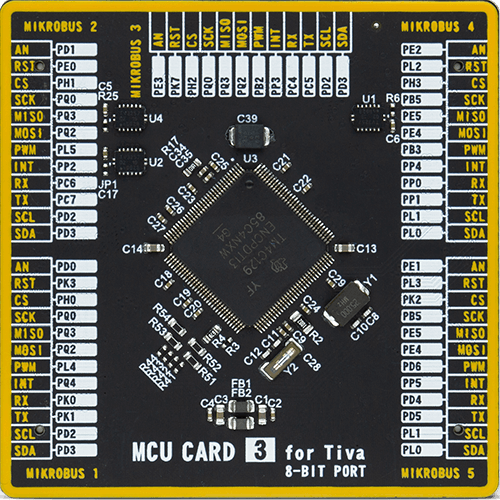
Type
8th Generation
Architecture
ARM Cortex-M4
MCU Memory (KB)
1024
Silicon Vendor
Texas Instruments
Pin count
128
RAM (Bytes)
262144
Used MCU Pins
mikroBUS™ mapper
Take a closer look
Click board™ Schematic

Step by step
Project assembly
Track your results in real time
Application Output
1. Application Output - In Debug mode, the 'Application Output' window enables real-time data monitoring, offering direct insight into execution results. Ensure proper data display by configuring the environment correctly using the provided tutorial.

2. UART Terminal - Use the UART Terminal to monitor data transmission via a USB to UART converter, allowing direct communication between the Click board™ and your development system. Configure the baud rate and other serial settings according to your project's requirements to ensure proper functionality. For step-by-step setup instructions, refer to the provided tutorial.

3. Plot Output - The Plot feature offers a powerful way to visualize real-time sensor data, enabling trend analysis, debugging, and comparison of multiple data points. To set it up correctly, follow the provided tutorial, which includes a step-by-step example of using the Plot feature to display Click board™ readings. To use the Plot feature in your code, use the function: plot(*insert_graph_name*, variable_name);. This is a general format, and it is up to the user to replace 'insert_graph_name' with the actual graph name and 'variable_name' with the parameter to be displayed.

Software Support
Library Description
This library contains API for IrThermo Click driver.
Key functions:
irthermo5v_get_t_ambient- Reads Temperature ambient from sensor.irthermo5v_get_t_object- Reads Temperature object from sensor.
Open Source
Code example
The complete application code and a ready-to-use project are available through the NECTO Studio Package Manager for direct installation in the NECTO Studio. The application code can also be found on the MIKROE GitHub account.
/*!
* @file main.c
* @brief IrThermo5V Click example
*
* # Description
* This application collects data from the sensor, and logs the results.
*
* The demo application is composed of two sections :
*
* ## Application Init
* Initializes IrThermo 5V Driver.
*
* ## Application Task
* Reading Ambient and Object Temperature and displaying the value periodically.
*
* @author Stefan Ilic
*
*/
#include "board.h"
#include "log.h"
#include "irthermo5v.h"
static irthermo5v_t irthermo5v;
static log_t logger;
static float measured_temperature;
static float object_temperature;
void application_init ( void ) {
log_cfg_t log_cfg; /**< Logger config object. */
irthermo5v_cfg_t irthermo5v_cfg; /**< Click config object. */
/**
* Logger initialization.
* Default baud rate: 115200
* Default log level: LOG_LEVEL_DEBUG
* @note If USB_UART_RX and USB_UART_TX
* are defined as HAL_PIN_NC, you will
* need to define them manually for log to work.
* See @b LOG_MAP_USB_UART macro definition for detailed explanation.
*/
LOG_MAP_USB_UART( log_cfg );
log_init( &logger, &log_cfg );
log_info( &logger, " Application Init \r\n " );
log_printf( &logger, "------------------------------\r\n " );
// Click initialization.
irthermo5v_cfg_setup( &irthermo5v_cfg );
IRTHERMO5V_MAP_MIKROBUS( irthermo5v_cfg, MIKROBUS_1 );
err_t init_flag = irthermo5v_init( &irthermo5v, &irthermo5v_cfg );
if ( I2C_MASTER_ERROR == init_flag ) {
log_error( &logger, " Application Init Error. " );
log_info( &logger, " Please, run program again... " );
for ( ; ; );
}
log_info( &logger, " Application Task \r\n" );
log_printf( &logger, "------------------------------\r\n " );
}
void application_task ( void ) {
measured_temperature = irthermo5v_get_t_ambient( &irthermo5v );
object_temperature = irthermo5v_get_t_object( &irthermo5v );
log_printf( &logger, " Ambient Temperature: %.2f C\r\n ", measured_temperature );
log_printf( &logger, " Object Temperature: %.2f C\r\n ", object_temperature );
log_printf( &logger, "------------------------------\r\n " );
Delay_ms ( 1000 );
}
int main ( void )
{
/* Do not remove this line or clock might not be set correctly. */
#ifdef PREINIT_SUPPORTED
preinit();
#endif
application_init( );
for ( ; ; )
{
application_task( );
}
return 0;
}
// ------------------------------------------------------------------------ END
Additional Support
Resources
Category:Temperature & humidity
